ISC Biology Previous Year Question Paper 2015 Solved for Class 12
(Candidates are allowed additional 15 minutes for only reading the paper. They must NOT start writing during this time.)
- Answer all questions in Part I and six questions in Part II, choosing two questions from each of the three sections A, B and C.
- All working including rough work should be done on the same sheet as, and adjacent to, the rest of the answer.
- The intended marks for questions or parts of questions are given in brackets [ ].
Part-I
(Attempt all questions)
Question 1.
(a) Give a brief answer for each of the following : [4]
(i) What is heterosis?
(ii) Why is non-cyclic photophosphorylation considered as a non-cyclic pathway?
(iii) Define test cross.
(iv) What are introns?
(b) Each of the following question(s)/statement(s) has four suggested answers. Choose the correct option in each case. [4]
1. Triple Fusion involves :
(i) Fusion of one male gamete with female gamete
(ii) Fusion of tube nucleus with generative nucleus
(iii) Fusion of two polar nuclei
(iv) Fusion of second male gamete with two polar nuclei
2. An EEG represents spontaneous electrical activity of the :
(i) Kidney
(ii) Spinal cord
(iii) Heart
(iv) Brain
3. The genotype of a person with Turner’s syndrome will be :
(i) 44 + XXY
(ii) 44 + XYY
(iii) 44 + XO
(iv) 44 + XXYY ’
4. Transcription is the transfer of genetic code from a DNA molecule to :
(i) RNA molecule
(ii) Second DNA molecule
(iii) Ribosomal subunit
(iv) Sequence of amino acids in a protein molecule
(c) Give a scientific term for each of the following: [4]
(i) The first formed category of photosynthetic organisms.
(ii) The surgical removal of a section of fallopian tube.
(iii) An animal behaviour which benefits others but is of no advantage to itself.
(iv) The hydrostatic pressure developed inside the cell on the cell wall due to endosmosis.
(d) Expand the following abbreviations : [4]
(i) STD
(ii) NADP
(iii) MRI
(iv) DDT
(e) Name the scientists who are associated with the following : [4]
(i) Discovered the fossil of Australopithecus
(ii) Microspheres
(iii) Coined the term Diffusion Pressure Deficit
(iv) Invented the CT scan
Answer:
(a) (i) Heterosis is the increased hybrid vigour displayed by the offspring from a cross between
genetically different parents.
(ii) Non-cyclic photophosphorylation is considered as non-cyclic pathway because electrons expelled by the excited photo centre does not return to it. It produces both ATP and NADPH.
(iii) Test cross is a special type of back cross made between the individual with a dominant trait and its recessive parent in order to know whether the homozygous or heterozygous for the trait.
(iv) Introns are the segment of DNA that does not code for the gene product. They are transcribed in primary transcript but are subsequently removed from the transcript before translation.
(b)
1. (iv) Fusion of second male gamete with two polar nuclei.
2. (iv) Brain
3. (iii) 44 + XO
4. (i) RNA molecule
(c) (i) Photoautotrophic bacteria
(ii) Tubectomy
(iii) Commensalism
(iv) Turgor pressure
(d) (i) Sexually Transmitted Disease.
(ii) Nicotinamide Adenine Dinucleotide Phosphate.
(iii) Magnetic Resonance Imaging.
(iv) Dichloro diphenyl trichloroethane.
(e) (i) Dart (1924) fossil of a child called Taung Baby.
(ii) Fox (1957)
(iii) Meyer (1938).
(iv) Godfrey Hounsfield (1972)
Part-II (50 Marks)
Section-A
(Answer any two questions)
Question 2.
(a) Give any three characters that have developed during human evolution. [3]
(b) Explain the term homogeny. [1]
(c) Give any two distinctive features of Dryopithecus. [1]
Answer:
(i) Bipedal locomotion
(iii) Free grasping hands
(v) Brain, speech and memory.
(b) Chemogeny or chemical evolution in which the elements in the early atmosphere combined to produce simple and compound molecules, ultimately leading to the formation of complex organic molecules.
(c) (i) Walked semi-erect on kunckles.
(ii) Snout was slightly projecting.
(iii) Brow ridges were absent.
(iv) Forelimbs and hindlimbs were of the same size. (Any two points)
Question 3.
(a) Explain the evolution of giraffe’s neck according to Lamarck’s theory of evolution. [3]
(b) Give two chromosomal similarities between man and apes. [1]
(c) Name any two temporary embryonic structures invertebrates which provide evidence for evolution. [1]
Answer:
(a) Giraffe : According to Lamarck, Giraffe was initially deer-like animal who browsed on herbs and shrubs. However, due to famine-like conditions, food became scarce on the ground. It was, however, present on high shrubs and trees. As a result, the ancestors of Giraffe stretched their body, forelimbs and neck. There was slight success. The trait was passed to the next generation where stretching caused a further enlargement. The process continued for several generations. It increased the size of the animals, produced long forelimbs and a long neck of present-day Giraffe.
(b) Chromosomal similarities between man and apes.
- Total amount of DNA in both is more or less similar.
- Banding pattern of individual human chromosomes is very similar to the banding pattern of corresponding chromosomes in apes.
(c) Temporary embryonic structures in vertebrates.
- gill clefts
- tail
Question 4.
(a) Persons suffering from sickle cell anaemia are at an advantage in Malaria infested areas. Explain. [3]
(b) Define the term gene flow. [ 1 ]
(c) What are analogous organs? Describe with one example from the plant kingdom. [1]
Answer:
(a) Sickle cell anaemia is an autosomal disorder in which the erythrocytes become sickle-shaped under oxygen deficiency as during strenuous exercise and at high altitudes. The disorder or disease is caused by the formation of an abnormal haemoglobin called haemoglobin-S. As found out by Ingram (1958), haemoglobin-S differs from normal haemoglobin-A in only one amino acid-6th amino acid of P-chain, glutamic acid, is replaced by valine. This is the major effect of the allele.
During conditions of oxygen deficiency 6-valine forms hydrophobic bonds with complementary sites of other globin molecules. It distorts their configuration. As a result, erythrocytes having haemoglobin-S become sickle-shaped. This is one of the secondary effects. The homozygotes having only haemoglobin S usually die before reaching maturity because erythrocyte distortion and degeneration occur even under normal oxygen tension.
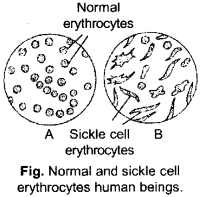
Despite having harmful effect, the allele for sickle-cell anaemia continues to persist in human population because it has survival value in malaria-infested areas like tropical Africa. Malarial parasite is unable to penetrate the erythrocyte membrane and cause any harm. Further, the sickle cell heterozygotes do not suffer from syndrome. Their erythrocytes appear normal till ‘ there is oxygen deficiency when some sickle-shaped etythrocytes may be observed.
Note : The gene for sickle-celled erythrocytes is represented by Hbs while that of normal erythrocytes is written as HbA. The homozygotes for the two types are Hbs and HbA. The heterozygotes is written as HbA Hbs.
(b) Gene flow is the addition or loss of alleles from a population due to the entry or exit of a section of population. It reduces the differences in the gene pools of separate populations.
(c) Analogous organs are those having similar outward form and function but quite different in anatomy and development e.g., tendrils help in climbing, in coiling around a support may be modified stipules (Smilax) in leaf-apex (Gloriosa), leaf-let (Pisum), whole leaf (Lathyrus) and stem-tendril (cucurbita, grapevine, passiflora).
Section-B
(Answer any two questions)
Question 5.
(a) With the help of diagrams, name and describe the different types of placentation seen in angiosperms. [4]
(b) Give four points of anatomical differences between a monocot stem and a dicot stem. [4]
(c) Define the following terms : [2]
(i) Racemose inflorescence
(ii) Osmotic pressure
Answer:
(a) Placentation : Placenta is a parenchymatous cushion present inside the ovary where ovules are borne. An ovary may have one or more placentae. The number, position and arrangement or distribution of placentae inside an ovary is called placentation. It is of . the following types :
1. Marginal : A single longitudinal placenta having one or two alternate rows of ovules occurs along the wall of the ovary called ventral suture. Marginal placentation is found in monocarpellary pistils of leguminosae (e.g., Pea, Cassia, Acacia) and other plants (e.g., Larkspur).
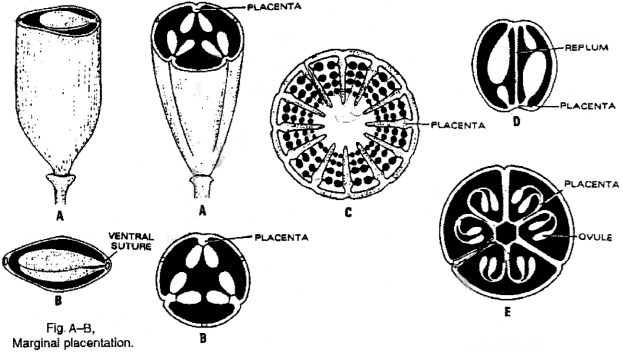
Fig. Parietal placentation. A~B. normal panetai placentation. C, parietal placentation of Poppy. D, parietal placentation in Brasslca. E, modified parietal placeniation of Cucurbits.
2. Parietal: Two or more longitudinal placentae develop along the wall of a syncarpous or compound pistil. The number of placentae correspond to the number of fusing carpels, e.g., two (Fun aria), three (Viola), four (Capparis). The ovary is usually unilocular (Fig. A-B) but modifications occur in many. In polycarpellary syncarpous pistil of poppy the ovule bearing placentae grow inwardly to form incomplete septa. A false septum called replum develops between the two parietal placentae in Mustard and other members of family Cruciferae. The ovary becomes bilocular. In the tricarpellary syncarpous pistil of cucurbits the three placentae grow inwards to meet in the centre and then bend outwardly. The ovary, therefore, becomes trilocular.
3. Axile : It occurs in syncarpous pistils. The ovary is partitioned into two or more chambers. Placentae occur in the central region where the septa meet so that an axile column bearing ovules is formed, e.g., Petunia (bilocular), Asphodelus (trilocular), Shoe Flower (pentalocular), Althaea (multilocular).
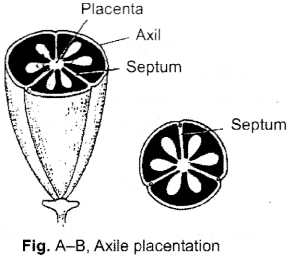
4. Free central : The pistil is polycarpellary and syncarpous but the ovary is unilocular. The ovules are borne around a central column which is not connected with the ovary wall by any septum, e.g., Pink (Dianthus), Silene, Primula.
5. Basal: The pistil can be monocarpellary or syncarpous. The ovary is unilocular. It bears a single placenta at the base with generally a single ovule, e.g., Ranunculus, Sunflower.
6. Apical : The ovary is unilocular and bears a single ovule that hangs from the tip of the chamber, e.g.. Cannabis. The terms sub-basal or sub-apical are used for single ovules borne on one side near the base or apex.
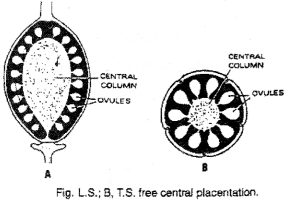
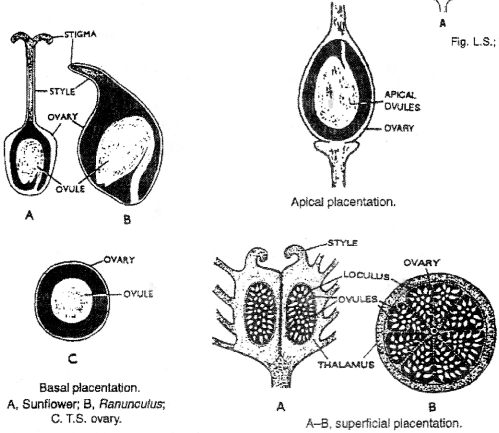
7. Superficial: The ovules develop on the whole inner surface of the ovary including the septa, if present. Superficial placentation is found in both monocarpellary (e.g., Butomus) and syncarpous (e.g., Nymphaed) pistils.
(b)
| Monocot Stem | Dicot Stem |
| (i) Epidermal hairs absent. | (i) Multicellular epidermal hairs present. |
| (ii) Ground tissue undifferentiated. | (ii) Ground tissue differentiated into cortex, endodermis and pericycle. |
| (iii) Vascular bundles are scattered in ground tissue. | (iii) Vascular bundles are arranged in a ring. |
| (iv) Vascular bundles are conjoint collateral and closed. | (iv) Vascular bundles are conjoint, collateral and open. |
| (v) Pith absent. | (v) Pith present. |
| (vi) Xylem tracheids and vessels oval in outline. | (vi) Tracheids and vessels are polygonal in outline. |
| (vii) Secondary growth absent. | (vii) Secondary growth present. |
(c)
- Racemose inflorescence is a indefinite inflorescence in which the growing point of the flowering axis i.e. peduncle continues its growth, producing flowers laterally in an acropetal manner.
- Osmotic pressure is the maximum pressure that cars be developed in a solution separated from pure water by a semipermeable membrane.
Question 6.
(a) Draw a diagram of the internal structure of the human ovary.
(b) Define the term water potential. What are its components? Explain.
(c) Give definition and importance of:
(i) Imbibition
(ii) Parturition
Answer:
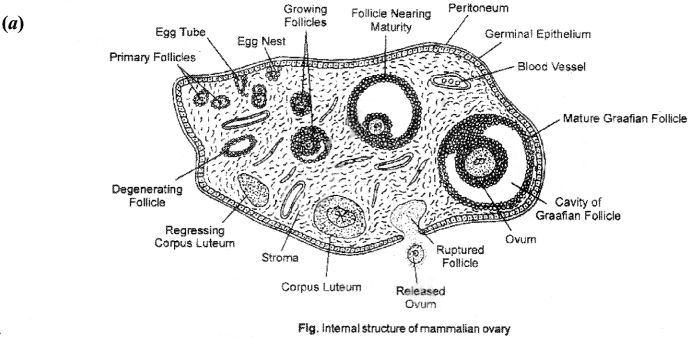
(b) The difference between the free energy of water molecules in pure water and the energy of water in any other system (e.g., water in a solution or in a plant cell or tissue) is called water potential. The Greek letter psi the symbol for which is Ψ designates the water potential in a system. The water potential is measured in bars; a bar is a pressure unit, which equals 14.5 lb! n2 750 mm Hg or 0-987 atm.
Water potential (Ψ) of protoplasm of the cell is equal but opposite in sign to the diffusion pressure deficit (DPD) or suction pressure (SP). The water potential of a solution can be determined using pure water as standard of reference. The pure water at atmospheric pressure has a water potential of zero (i)). The presence of solute particles reduces the energy of water and thus decreases the water potential (negative). Therefore, the water potential of a solution is always less than zero. The direction of flow of water between the two regions will take place from the region of higher water potential (pure water) to the region of lower water potential (as in a solution), energetically downhill.
Components a water potential :
The typical plant cell consists of a cell wall, a vacuole filled with an aqueous solution and a layer of cytoplasm between the vacuole and the cell wall. When such a cell is subjected to the movement of water, many factors begin to operate which ultimately determine the water potential of cell sap. For solutions, such as contents of cells, water potential is determined by three major sets of internal factors viz., matric potential (Ψ rn), solute potential (Ψ s) and pressure potential (Ψ p). The water potential (Ψ) in a plant cell or tissue can be written as the sum of the matric potential (Ψ m) due to binding of water to cell walls and cytoplasm, the solute potential (Ψ s) due to concentration of dissolved solutes, which by its effect on the entropy components reduces the water potential and the pressure potential (Ψ p) due to hvdrostatic pressure, which by its effect on the energy components increases the water potential:
Ψ = Ψ m + Ψ s + Ψ p …………………… (1)
Each component potential is discussed separately below :
Matric potential (Ψ m) : Matric is the term used for the surface (such as, soil particles; cell walls; protoplasms etc.) to which water molecules are adsorbed. The matric potential (Ψ m) is the component of water potential influenced by the presence of a matrix. It has got a negative value. In case of plant cells and tissues, the matric potential is often disregarded because it is not significant in osmosis. Thus, the above equation (1) may be simplified as follows :
Ψ = Ψs + Ψp ………………………. (2)
Solute potential (Ψ s) : Solute potential is also known as Osmotic potential. It is defined as the amount by which the water potential is reduced as a result of the presence of solute. Solute potentials or osmotic potentials (Ψ s) are always in negative values (number). The term solute potential takes the place of osmose pressure, expressed in bars with a negative sign.
Pressure potential (Ψ s) : Plant cell wall is elastic and it exerts a pressure on the cellular contents. As a result of inward wall pressure, hydrostatic pressure is developed in the vacuole termed as turgor pressure. The pressure potential is usually positive and operates in plant cells as wall pressure and turgor pressure.
(c)
- Imbibition is the phenomenon of adsorption of water or any other liquid by the solid particles of a substance without forming a solution.
- Imbibition is the initial step in the germination of seeds, when seed coats imbibe water ‘ followed by embryo and endosperm.
- Imbibition cause swelling of seeds and breaking of testa.
- The imbibition is dominant in the initial stage of water absorption by root hair cells.
- Water moves into ovules which are ripening into seeds by the process of imbibition.
(d) Parturition : It is the act of expelling the full term young one/foetus from the mother uterus at the end of gestation period. Hormones play a major role in parturition.
It is important that baby bom when it is mature. The foetal signals that it is mature by secreting certain hormones. The hormones diffuse across the placenta into mother’s blood, where they cause the excretion of oxytocin from her pituitary oxytocin stimulate the uterine contractions. This provides force to expel the baby from the uterus causing birth.
As a result of parturition, milk is produced in the female’s breasts following the birth of a young one. The actual release of milk, requires the presence of oxytocin, to bring contraction of smooth muscles of the ducts within the mammnary glands.
Question 7.
(a) Give four adaptations in flowers pollinated by insects. [4]
(b) Describe the mass flow hypothesis for translocation of organic solutes (food) in plants. [4]
(c) Write a brief note on the causes of infertility. [2]
Answer:
(a) Characters of Anemophilous Flowers (Insect-pollination)
- Flowers are small and inconspicuous.
- Non-essential floral parts are reduced or absent.
- Flowers are usually colourless, nectarless and odourless.
- Flowers are developed above the foliage, usually in hanging spikes or catkins.
- Male flowers are more abundant in case of unisexual flowers. In bisexual flowers stamens are more abundant.
- Anthers are exserted and versatile.
- Pollen grains are small and light. They may have air sacs or wings.
- Pollen grains are dry and unwettable. This protects the pollen from moisture present in the air.
- Stigmas are exserted, hairy feathery or branched to capture the pollen grains. The cob of Maize has elongated stigmas
- and styles which sway in wind to trap pollen grains.
- A very large number of pollen grains are produced, e.g., 500000 per flower in Cannabis, 25 million by a tassel of Maize and 135 million by Mercurialis.
- Pistils commonly possess single ovules.
Examples. Anemophily is common in grasses. Other examples are Amaranthus, Cannabis, Chenopodium, Coconut, Date, Mulberry, Poplar, Willow, etc.
(Any four points)
(b) Mass Flow or Pressure Flow Hypothesis : It was put forward by Munch (1927, 1930). According to this hypothesis, organic substances move from the region of high osmotic pressure to the region of low osmotic pressure in a mass flow due to the development of a gradient of turgor pressure. This can be proved by taking two interconnected osmometers, one with high solute concentration. The two osmometers of the apparatus are placed in water (Fig.). More water enters the osmometer having high solute concentration as compared to the other. It will, therefore, come to have high turgor ‘pressure which forces the solution to pass into the second osmometer by a mass flow. If the solutes are replenished in the donor osmometer and immobilised in the recipient osmometer, the mass flow can be maintained indefinitely.
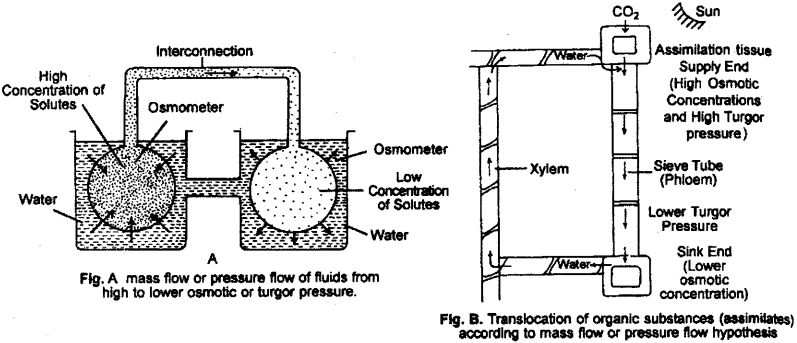
Fig. B. Translocation of organic substances (assimilates) according to mass flow or pressure flow hypothesis Sieve tube system is fully adapted to mass flow of solutes. Here the vacuoles are fully permeable because of the absence of tonoplast. A continuous high osmotic concentration is present in the mesophyll cells (due to photosynthesis) and storage cells (due to mobilization of reserve food). The organic substances present in them are passed into the sieve tubes (by means of transfer cells).
A high osmotic concentration, therefore, develops in the sieve tubes of the source. The sieve tubes absorb water from the surrounding xylem and develop a high turgor pressure (Fig.). It causes the flow of organic solution toward the area of low turgor pressure. A low turgor is maintained in the sink region by converting soluble organic substances into insoluble form. Water passes back into xylem.
(c) Causes of infertility : Infertility is the failure to conceive when after to 1-2 years of regular unprotected sex i.e., inability to produce offspring. Infertility can be defined as relative sterility. Infertility is caused by defects found in male, female as well as both.
Infertility in Males:
- Cryptorchidism or failure of testes to descend into scrotum.lt causes azospermia.
- Absence or blockage of vasa deferentia and vasa efferentia.
- Hyperthermia or higher scrotal temperature due to varicocele (varicose veins), hydrocele or filariasis, tight undergarment, thermal undergarment or working in hot environment,
- Infection like mumps after puberty, infection of seminal vesicle.
- Alcoholism inhibits spermatogenesis.
- Gonadotropin deficiency.
- Cytotoxic drugs, radiations, antidepressant and anticonvulsant drugs depress spermatogenesis.
Infertility in Females : The various causes of infertility in females are as follow :
- Anovulation (nonovulation) and oligoovulation (deficient ovulation).
- Inadequate growth and functioning of corpus luteum resulting in reduced progesterone secretion and deficient secretory changes in endometrium.
- The ovum is not liberated but remains trapped inside the follicle.
- Fallopian tube may fail to pick up ovum, have impaired motility, loss of cilia and blocked lumen.
- Noncanalisation of uterus.
- Defective uterine endometrium due to either reduced or excessive secretory activity.
- Congenital malformation of uterus.
- Fibroid uterus.
- Defects in cervix like congenital elongation, occlusion of cervix by a polyp, cervicitis, scanty or excessive cervical mucus.
- Defective vaginal growth like atresia and transverse septum.
Section-C
(Answer any two questions)
Questions 8.
(a) Give any four reasons for Mendel’s success. [4]
(b) Briefly describe the technique employed in DNA fingerprinting. [4]
(c) Give any two features of Genetic Code. [2]
Answers:
(a) Reasons for Mendel’s Success :
- Mendel selected only pure breeding varieties of Pea (Pisum sativum) for his experiments.
- Mendel took only those traits for his studies which did not show linkage, interaction or incomplete dominance.
- Mendel took one or two characters at one time for his breeding experiments while his predecessors often studied all the traits simultaneously.
- Mendel’s experimental plant Pea (Pisum sativum) is ideal for controlled breeding. It is • cross-breed manually while normally it undergoes self breeding.
- He took care to avoid contamination from foreign pollen grains brought by insects.
- Mendel kept a complete record of every cross, subsequent self breeding and the number of seeds produced.
- He formulated theoretical explanations for interpreting his results. His explanations were further tested by him as to their validity.
- Mendel used statistical methods and law of probability analysing his results.
- Mendel was lucky in selecting those traits, the genes of which were either present on different chromosomes or showed recombination. (Any four points)
(b) Southern Blot Technique:
The Southern blot is one way to analyze the genetic patterns which appear in a person DNA. Performing a Southering Blot involves :
Source of DNA : White blood corpuscles, blood, semen, saliva, vaginal swabs, skin cells, bone cells, cells from hair root, etc. are used as a source of DNA for fingerprinting. The amount of DNA required can be met by 1 microgram of tissue or 1,00,000 cells.
- Isolation and Extraction – Isolation of DNA from DNA source cells in a high speed refrigerated centrifuge.
- DNA Amplification – Many copies of extracted DNA are made by PCR-technique.
- Fragmentation/Digestion of DNA by restriction endonuclease to produce VNTRs.
- Separation of DNA fragments (VNTRs) by size through gel electrophoresis.
- Single stranded DNA – Denaturing of VNTRs either by heating or chemically treating the fragments in the gel.
- Southern Blotting – Transferring (blotting) of separated single-stranded DNA fragments to synthetic membranes such as nitrocellulose or nylon.
- Hybridisation – Using radioactive/labelled VNTR probe.
- Exposure to X-Ray films/Autoradiography – Detection of hybridised DNA by autoradiography.
- After hybridisation autoradiography shows many dark bands of different sizes.
- These bands give a characteristic pattern for an individual DNA.
DNA prints or DNA profiles of dead bodies are compared with DNA prints of the close, blood relatives (sisters, brothers, parents) to determine the identity of the dead bodies.
(c) Characteristics of Genetic Code :
- Triplet Code : Three adjacent nitrogen bases constitute a codon which specifies the placement of one amino acid in a polypeptide.
- Start Signal: Polypeptide synthesis is signalled by two initiation codons – methionine AUG or codon and GUG or valine codon.
- Stop Signal: Polypeptide chain termination is signalled by three termination codons – UAA (ochre), UAG (amber) and UGA (opal). They do not specify any amino acid and are hence also called nonsense codons.
- Universal Code : The genetic code is applicable universally, i.e., a codon specifies the same amino acid from a virus to a tree or human being. Thus, /wRNA from chick oviduct introduced in Escherichia coli produces ovalbumin in the bacterium exactly similar to one formed in chick.
- Nonambiguous Codons : One codon specifies only one amino acid and not any other.
- Related Codons : Amino acids with similar properties have related codons, e.g., aromatic amino acids tryptophan (UGG), phenylalanine (UUC, UUU), tyrosine (UAC, UAU). (Any four points)
Question 9.
(a) Explain the mechanism of action of T-cells to antigens. [4]
(b) Explain how insulin can be produced using recombinant DNA technology. [4]
(c) What is pisiculture? Give one advantage. [2]
Answer:
(a) Mechanism of action of T-cells : On coming on contact with an antigen, a T-lymphocyte forms a clone of lymphocytes. The clone has 4 types of T-cells – helper T-cells, killer T-cells, supressor T-cells and memory T-cells. Out of these, the first three types are also called effector T-cells.
(i) Helper T-cells – They form 75% of the total lymphocytes of a clone. They secrete lymphokines for performing several types of functions like proliferation of other T-cells, stimulation of B-lymphocytes, attraction of macrophages and feedback system.
(ii) Killer or Cytotoxic T-cells – The T-cells reach the site of infection, come in contact with microbes and secrete perforins. Perforins produce holes. It is followed by secretion of toxic chemicals or lymphotoxins into the microbes for killing the same. Soon after a killer T-cell separates and . attacks another pathogen. Cytotoxic T-cells also attack cancer cells, cells of transplanted organs and helper T-cells invaded by HIV.
(iii) Supressor T-cells – They are protective T-cells which inactivate immune system,
(vi) Memory T-cells – They are those T-cells which were previously sensitised and retain the sensitisation for future.
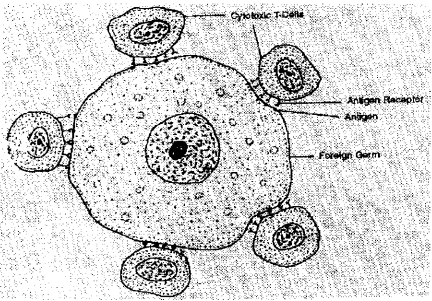
Fig. Killing of foreign cell by cytotoxic T-cells.
(b) Insulin is a hormone produced by the pancreas which is a large gland present near, the stomach. This hormone is necessary for the body’s correct use of food, especially sugar. Insulin works by helping the sugar that penetrates the cell wall, where it is then utilized by the cell. In diabetic persons, the body either does not make enough insulin or the insulin that is produced cannot be used properly.
Insulin is the first genetically engineered hormonal drug ever marketed anywhere in the world. It was produced first in 1980 by Eli Lilly (U.S.A.) with the name Humulin by transferring the insulin gene into E. coli.
Insulin gene is transferred into a bacterial cell (E. coli) in the following two steps :
1. Transfer of the Insulin Gene into a Plasmid
Vector : The plasmid is cut across both strands by a restriction Transfer of the insulin gene enzyme leaving the loose, sticky ends to which DNA Restriction ^ human can be attached. Special linking sequences (called linkers) are added to the human cDNA (complemen- aoning the ,nsu|in Gene tary DNA) so that it will fit precisely into the loose ends of the opened ring of plasmid DNA. The plasmid containing the human gene, also called a recombinant plasmid, is now ready to be inserted into another organism such as a bacterial cell (E. coli). fig. Transfer and cloning of insulin gene.
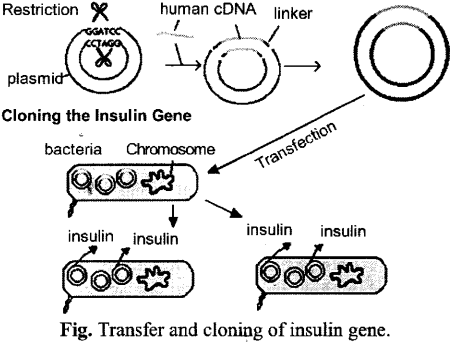
2. Cloning the Insulin Gene : The recombinant plasmids and the bacterial cells are mixed up. Plasmid enters the bacterial cell through a process called transfection (Fig.) The . plasmid containing the human cDNA present inside bacterial cells is multiplied to get several dozen copies. When the bacteria divide, the plasmids also divide. Thus two daughter cells and the plasmids continue to reproduce. With cells dividing rapidly (every 20 minutes), a bacterium containing human cDNA (encoding for insulin) will shortly produce many millions of similar cells called clones containing the same human gene. In this way a large number of insulin molecules can be commerically produced in a fermentor.
Or
(b) Insulin Production r-DNA technology
- A DNA fragment encoding each insulin chain was made by annealing two complementary oligonucleotides that had been chemically synthesised.
- Each fragments was ligated into a bacterial expression vector such that during translation the insulin chain would be fused to the carboxy terminus of the beta-galactosidase enzyme.
- The expression vectors, were transformed into E.coli and the beta-insulin fusion proteins accumulated inside the bacterial cells.
- The cells were harvested and each beta-gal-insulin fusion protein was purified.
- The insulin coding DNA was synthesised so that it started with a methionine codon. This provides a way to cleave off the beta-gal part from the insulin polypeptide.
- Treatment of the fusion protein with cyanogens bromide (CNBr) cleave the peptides bonds after the methionine.
Thus, in this way recombinant insulin is produced in E.coil.
(c) Pisciculture is cultivating, rearing and harvesting of fish. Fish is an important source of food, rich in iodine and other minerals. Fish liver oil is a good source .of vitamin A and D.
Question 10.
(a) Name the causative organism and preventive measures for each of the following : [4]
(i) Swine flu
(ii) Typhoid
(iii) Filariasis
(iv) Syphilis
(b) State four causes and four consequences of population growth
(c) Differentiate between:
(i) Cannabinoids and Barbiturates
(ii) Biotic potential and Carrying capacity.
Answer
| DiseaseCausative | agentPreventive | Measures |
| (i) Swine flu | H1N1 (virus) | Bearing of mask in contact with patients. |
| (ii)Typhoid | Salmonella typhi (Bacteria) | Avoid contaminated food and water. |
| (iii) Filariasis | Wuchereria bancrofti (Helminth) | Avoid mosquito bite of especially culex. |
| (iv)Syphilis | Treponema pallidum (Spirochete Bacteria) | Avoid sex with many partners. |
(b) Population growth is the increase in size of the population over a period of time. Human population is growing at a fast rate exihibiting population explosion. The two primary reasons for increase in human population are :
- decreaes in death rate
- increase in longevity
Factors favouring population growth :
- Decrease in death rate.
- Increase in average life span.
- Better medical facilities.
- Control of insect vector’s of fatal diseases and epidemics.
- Better sanitation.
- Proper care of new-born children and their mothers.
- Better nutrition and life amenities.
- Protection against wildlife and adverse weather through living in houses. (Any four points)
Consequences : Overpopulation has become a serious world problem. With increase in population, the available natural resources will fall short of requirements.
The more important consequences are :
- Housing : New towns and cities are coming up to accommodate the growing population. This has put a great strain on agricultural land and forests. Clearing of forests for habitation and agriculture has caused new problems, particularly soil erosion and floods. Even with the coming up of new residential complexes, housing problem persists.
- Food : Large families with moderate means are unable to provide adequate and balanced diet to the children. The latter suffer from malnutrition and grow into less fit members of society.
- Employment : Rise in population has resulted in large scale unemployment. New employment schemes introduced by government have failed to absorb the fast growing numbers.
- Education : Increase in population has led to rush in educational institutions and lowering of educational standards. A large family is unable to afford higher education to the children.
- Medical Aid : Proper medical facilities are also beyond the reach of large families. State too is unable to look after the health of the ever-growing population.
(i) Cannabinoids:
- Hallucinogenic chemicals obtained from leaves, flowering tops of Cannabis sativa.
- Cannabinoid receptors are usually present in the air.
- They are hallucinogenic produce a dream-like state with disorientation loss of contact with reality etc.
Barbiturates:
- They are synthetic drugs.
- They are general depressant for all excitable cells, but the CNS is most sensitive to these drugs.
- They are hypnotic and sedative in action.
(ii) Biotic potential:
It is the maximum rate of increase of any organism if left to itself and isolated from its natural enemies, diseases or other inhibiting factors.
Carrying capacity:
- It is the total number of individuals that the environment can support.
